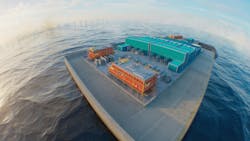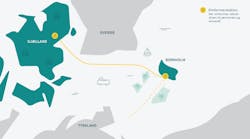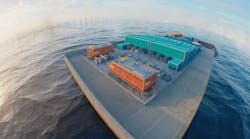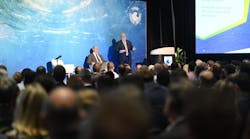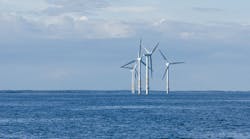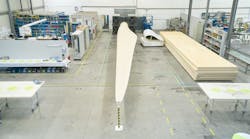Editor's note: This Renewable Energy column first appeared in the January-February 2024 issue of Offshore magazine. Click here to view the full issue.
By Bruce Beaubouef, Managing Editor
Developers are moving forward with plans to build two “energy islands” in the North Sea and Baltic Sea that will serve as large-scale offshore energy hubs for nearby offshore wind farms. As planned, these islands will connect surrounding wind farms with onshore power markets and will – developers hope – serve as the building blocks of an integrated European offshore electricity grid.
Last November, tendering started for the offshore Bornholm Energy Island project that will supply 3 GW of power to Germany and Denmark. The project is being developed by Energinet and 50Hertz, who have plans to create a power hub on the island of Bornholm that can provide electricity to consumers in Germany or Denmark, and possibly more widely. The partners aim to start awarding contracts in the second half of 2024, and they also plan on splitting the tender into multiple contracts.
50Hertz has already signed a contract for procurement of HVDC cables for Bornholm Energy Island, while Energinet has initiated the tender of one contract for production of cables and for offshore installation. Onshore installation and horizontal directional drilling will form a separate contract as will the surveying and removal of unexploded ordnance.
Construction on the Danish part of the project can begin once an environmental permit has come through and archaeological excavations have been completed, anticipated in 2025. In Germany installation and construction can start after the authorities have granted permits.
Meanwhile, work should get underway soon on Princess Elisabeth Island, described as the “the world’s first artificial energy island,” located some 45 km off the Belgian coast. The Belgian consortium TM EDISON, including DEME and Jan De Nul, has won the tender for the construction of Princess Elisabeth Island.
The construction of the foundations of the island were expected to begin in early 2024 and will last 2.5 years. After that, the installation of the high-voltage infrastructure can be started. The latter will be necessary for bringing the electricity from Belgium’s future offshore wind zone to shore.
The island could also be the first building block of an integrated European offshore electricity grid that will connect various hubs and countries together. For instance, Belgium wants to build additional joint interconnections with Great Britain and Denmark.
DEME says Princess Elisabeth Island will be the world’s first artificial energy island that combines both direct current (HVDC) and alternating current (HVAC). The island’s high-voltage infrastructure will bundle the wind farm export cables of the Princess Elisabeth zone together, while also serving as a hub for future interconnectors with Great Britain (Nautilus) and Denmark (TritonLink). These are so-called "hybrid interconnectors" that have a dual function and are therefore said to be more efficient.
Now that the construction contract has been awarded, the design of the island can be finalized. The caissons will be built and installed in 2024 and 2025. These will form the contours of the island. After that, the base of the island will be raised and prepared for the construction of the electrical infrastructure. It will be connected with the new offshore wind farms and with the Elia onshore grid.
And just recently, Copenhagen Infrastructure Partners (CIP) announced that it is working on about 10 energy island projects in the North Sea area, the Baltic Sea and in Southeast Asia. According to the company, they combine existing, proven technologies in an innovative way and at a much larger scale, allowing for a cost-efficient build-out and integration of offshore wind. To advance these projects, CIP says it is launching Copenhagen Energy Islands, a new development company dedicated to developing energy islands globally with backing from Nordic, European and North American investors.
